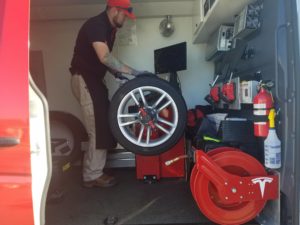Economical Mobile Tire Replacement Las Vegas - Call Now!
Economical Mobile Tire Replacement Las Vegas - Call Now!
Blog Article
Tire Service: Proven Methods for Optimal Tire Upkeep and Treatment
Keeping optimum tire condition is vital for both safety and security and efficiency of any car. From guaranteeing appropriate tire stress to regular rotation and placement, there are proven techniques that can considerably expand the life-span of your tires and boost general driving experience. As we check out the details of tire care and maintenance, we will certainly reveal important standards that every car proprietor need to adhere to for the best possible outcomes. Let's look into the world of tire solution and uncover the secrets to keeping your tires in superior shape for the long run.
Importance of Tire Stress
Appropriate tire stress is a vital element in making certain optimal vehicle efficiency and security on the road. Preserving the recommended tire pressure degrees offered by the manufacturer uses countless advantages. To start with, ample tire stress promotes much better fuel effectiveness, as under-inflated tires can result in enhanced rolling resistance, creating the engine to work more challenging and consume even more gas. Correct tire stress guarantees even step wear, improving tire durability and saving money in the lengthy run by delaying the requirement for premature substitutes. In addition, appropriately blew up tires add to enhanced handling and stopping capabilities, essential for risk-free driving in numerous road conditions. Over-inflated tires, on the other hand, can cause decreased traction and a harsher ride. Alternatively, under-inflated tires are prone to overheating, which can lead to accidents and blowouts. Routinely changing and checking tire pressure, especially soon trips, is a simple yet efficient method to enhance lorry efficiency, extend tire life expectancy, and focus on security on the roadway.
Tire Rotation Guidelines
When taking into consideration tire turning standards, it is vital to comprehend the significance of this maintenance task in optimizing tire life-span and keeping ideal vehicle performance. Tire turning includes changing the setting of each tire on a lorry to guarantee also step wear. Front tires often tend to use quicker than rear tires because of steering pressures, making regular rotation critical for balanced wear patterns. The advised turning pattern varies relying on whether a car is front-wheel, rear-wheel, all-wheel, or four-wheel drive. Typically, tires must be rotated every 5,000 to 7,500 miles, or as recommended in the automobile manual. Disregarding tire turning can bring about irregular wear, influencing handling, grip, and potentially compromising vehicle safety. By sticking to correct rotation standards, drivers can prolong the life of their tires, boost gas efficiency, and improve total driving experience. Routine turning is an easy yet reliable upkeep practice that adds considerably to tire longevity and lorry efficiency.

Advantages of Wheel Alignment
Making certain proper wheel alignment after tire rotation is vital for maintaining well balanced wear patterns and optimizing vehicle performance. Wheel alignment describes the modification of the angles of the wheels to the manufacturer's requirements. One of the vital advantages of wheel alignment is boosted handling and steering response. read here When the wheels are appropriately aligned, it decreases steering effort, making sure a smoother and a lot more regulated driving experience. Additionally, correct wheel alignment assists to expand the life expectancy of your tires. Misaligned wheels can create uneven tire wear, leading to early tire replacement and their website boosted maintenance costs.

Tire Footstep Deepness Check
Doing a normal evaluation of tire step deepness is necessary for maintaining risk-free driving problems and prolonging the life-span of your tires. Irregular walk wear can show issues with tire positioning, pressure, or suspension, highlighting the significance of normal walk deepness checks. By including tire step depth checks right into your regular maintenance schedule, you can drive with confidence understanding that your tires are in top condition.
Seasonal Tire Inspection
Seasonal tire evaluation is a basic aspect of tire maintenance that makes certain tires are all set to encounter the challenges postured by various climate problems. In prep work for wintertime, it is crucial to check the tire stress consistently as cold temperature levels can trigger tire pressure to go down. By conducting regular seasonal tire examinations, motorists can extend tire lifespan, boost gas efficiency, and most notably, guarantee a safe and secure driving experience in differing climate conditions.
Final Thought
In final thought, preserving appropriate tire stress, revolving tires frequently, aligning wheels appropriately, keeping an eye on walk deepness, and performing seasonal examinations are essential techniques for ideal tire treatment. By following these verified methods, drivers can ensure their tires last longer, execute better, and add to general car safety. It is necessary to focus on tire maintenance to stop mishaps, improve gas effectiveness, and extend the lifespan of tires.
Appropriate tire pressure promotes better fuel performance, as under-inflated tires can lead to enhanced rolling resistance, creating the engine to function harder and take in more fuel.When thinking about tire rotation standards, it is important Homepage to understand the importance of this maintenance job in taking full advantage of tire life expectancy and maintaining optimum car performance. Seasonal tire inspection is a fundamental facet of tire upkeep that guarantees tires are all set to encounter the obstacles presented by various weather condition conditions. By carrying out regular seasonal tire examinations, vehicle drivers can extend tire life expectancy, improve fuel efficiency, and most notably, guarantee a safe and secure driving experience in varying weather problems.
In conclusion, keeping appropriate tire stress, rotating tires routinely, aligning wheels appropriately, keeping track of step depth, and carrying out seasonal assessments are essential practices for ideal tire care.
Report this page